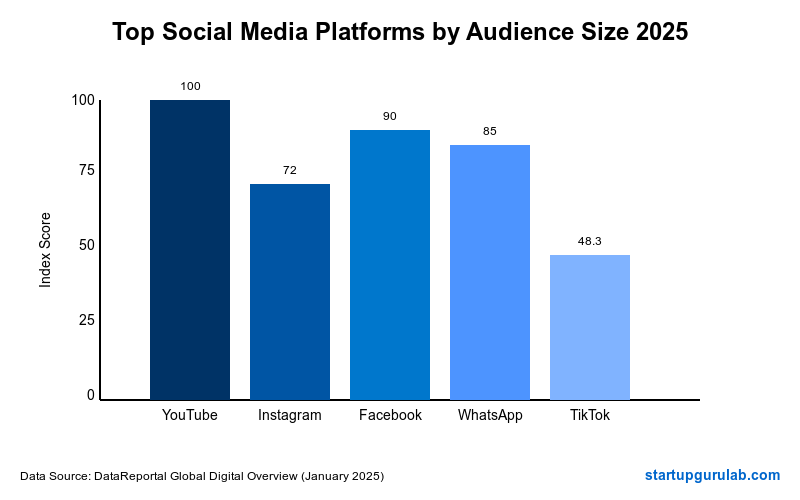- What is Business as Usual (BAU)? - October 8, 2025
- How Slack Grew to 10M Users Without Ads: Complete Growth Blueprint - October 8, 2025
- Top Startups in Kerala 2025 - September 26, 2025
As of March 2025, 5.42 billion people actively use social media worldwide. This represents a staggering 63.9% of the global population and 94.2% of all internet users. The social media landscape continues to grow, with 206 million new users joining various platforms in 2024 alone (a 4.1% annual growth rate).
How Much Time Do People Spend on Social Media Daily?
The average social media user spends 2 hours and 21 minutes on these platforms every day. This translates to an astonishing 12 billion hours collectively spent across the globe each day. With users actively engaging across an average of 6.8 different platforms monthly, social media’s grip on our daily routines remains stronger than ever.
Which Social Media Platform Has the Most Users in 2025?
The battle for social media dominance continues with clear winners emerging:
- YouTube stands as the undisputed leader with the largest audience (index score: 100)
- WhatsApp and Facebook (both Meta-owned) follow closely behind
- Instagram reaches approximately 72% of YouTube’s massive user base
- TikTok continues its meteoric rise with a 48.3 index score and the fastest-growing advertising audience

When it comes to advertising reach specifically:
- YouTube: 2.53 billion monthly ad viewers
- Facebook: 2.28 billion
- Instagram: 1.74 billion
- TikTok: 1.59 billion (rapidly closing the gap with Instagram)
What Percentage of Adults Use Social Media?
An overwhelming 86.3% of adults (ages 18+) use social media on a monthly basis. However, usage patterns vary significantly by demographic:
- Younger users (16-24): Prefer visual and short-form content platforms like Instagram and TikTok
- Older demographics: Still favor Facebook and WhatsApp for communication and news consumption
Why Do People Use Social Media in 2025?
Understanding user motivations provides valuable insights for marketers and platform developers:

- Staying connected with friends and family remains the primary driver (50.8% of users)
- Filling spare time continues to be a significant motivation
- News consumption motivates 34.5% of users
- Brand research has become increasingly important, with 50% of users actively seeking brand content
Interestingly, while 22% of users follow influencers overall, this engagement drops dramatically among older demographics, with only 4% of men aged 65+ following influencer accounts.
Which Regions Have the Highest Social Media Adoption?
Social media adoption varies dramatically by region:

- Eastern Asia leads with 97% adoption (driven largely by WeChat’s dominance in China)
- Latin America and Europe demonstrate robust engagement rates
- Sub-Saharan Africa lags with under 50% adoption
- Middle Africa shows the lowest rates with only 30% of internet users active on social platforms
The United States reports 253 million social media users (73% of the population), with Instagram and TikTok particularly dominant among younger Americans.
What Are the Emerging Social Media Platforms to Watch?
While established giants dominate, new contenders continue to emerge:
- Threads (Meta’s Twitter competitor) has reached 320 million monthly users but struggles with engagement (users spend only 39 minutes per month on the platform)
- Bluesky Social has gained 25 million users but faces significant retention challenges
What Challenges Face Social Media Marketers in 2025?
The evolving landscape presents several challenges for marketers:
- Audience overlap: 99% of users on platforms like Facebook or TikTok can be reached via other platforms, reducing the necessity for comprehensive omnichannel strategies
- Platform saturation: Growth is slowing as adoption approaches global population limits
- Future growth dependency: Emerging markets will determine the next phase of user acquisition
- Aging demographics: Different strategies needed for platforms with varying age distributions
Conclusion: The Future of Social Media in 2025 and Beyond
Social media remains central to global digital life, with YouTube and Meta platforms dominating user activity. However, regional disparities, changing demographics, and platform saturation signal the need for evolving strategies.
For businesses and marketers, success will likely depend on embracing video content (particularly on YouTube and TikTok), developing localized campaigns for specific regions, and forming strategic partnerships with influencers who resonate with target audiences.
As we move further into 2025, expect to see continued consolidation among major platforms while niche communities develop around specific interests and content types. The social media landscape continues to evolve, but its central role in digital life shows no signs of diminishing.

